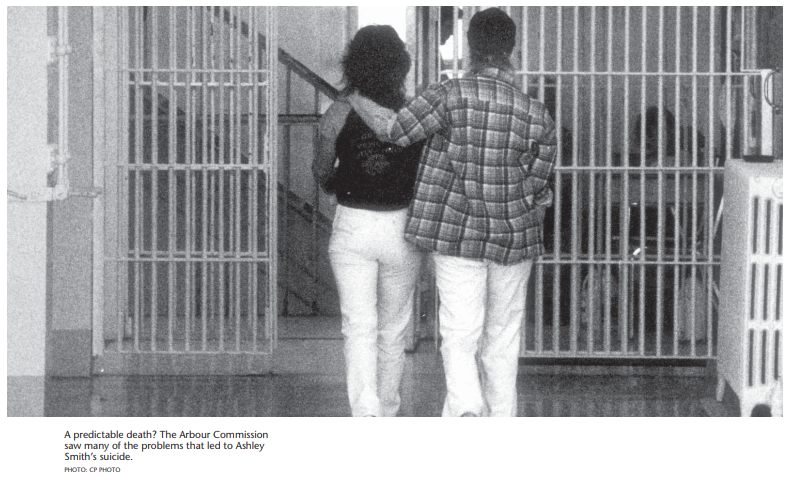
On the morning of October 19, 2007, 19-year-old Ashley Smith died on the cement floor of her federal prison segregation cell, wearing nothing more than a security gown. Smith was a prisoner with a history of behavioural and mental health issues, and at the time of her death she was on suicide watch. Despite these facts, correctional staff at Grand Valley Institution (GVI) in Kitchener, Ontario, watched as she tied a ligature around her neck and continued observing for over 30 minutes as Smith lay on the ground between the wall and her cot. When they finally entered the cell, they were too late to revive her.
Over the following years the public outcry grew, as information slowly became public about how the Correctional service of Canada (CSC) handled Smith during her incarceration. While the first coroner’s inquest was abandoned before completion, the second is scheduled to begin hearing witnesses in January 2013. However, before testimony is heard and conclusions are drawn, it is clear from the already public record that the CSC violated some of its own policies. This is not the first time that the CSC has been called to account by the judiciary for breaking its own guidelines for handling difficult prisoners. In fact, it is the CSC’s enduring culture of relying on punitive measures with its most troubled prisoners that made Ashley Smith’s death not only preventable, but predictable.
The Smith case bears eerie similarities to what was referred to in official inquiries as “certain events” at the Kingston Prison for Women (P4W) in 1994, where eight women were illegally subjected to strip searches by a male Institutional Emergency Response Team. Just as it did in the aftermath of Smith’s death, the federal government went to court to prevent public disclosure of videotaped evidence. In a subsequent inquiry into the Kingston incident, Justice Louise Arbour determined that the CSC not only violated the women’s human rights but also broke its own institutional policy regulations. Arbour highlighted a number of systemic issues in prison operations that required change, including the unjust duration, conditions and use of segregation; the ill-equipped grievance system; the inappropriate use of force; and the need for a separate governance stream for women’s corrections.
The same policy and procedural flaws identified by Arbour were present in the death of Ashley Smith. In this article we outline some of the key legal and policy violations in the Smith case, and we draw connections to the earlier incident at the Kingston Prison for Women (now closed). Despite the creation of six new regional prisons for women, the CSC continues to repeat the same mistakes it made in 1994, largely because its over-assessment of risk encourages excessively punitive handling of hard-to-manage prisoners.
Ashley Smith’s incarceration began in October 2003, when the 15-year-old was sentenced as a part-time resident to the New Brunswick Youth Centre for breaching her probation. She had left her parents’ property and thrown crab apples at a postman. Her initial month-long sentence eventually extended to over four years, largely as punishment for numerous infractions she accumulated at the youth centre and later while in federal custody. Smith was repeatedly charged with threatening behaviour and assault for biting, punching and spitting on staff when they attempted to physically subdue her. Upon entering the federal prison system, Smith began a series of attempts to hurt herself, and the majority of the over 150 institutional infractions she accumulated in federal custody were in response to these self-injurious acts.
The primary correctional response to self-injurious behaviour is to place the prisoner on suicide watch, which consists of moving them to administrative segregation — or what the CSC calls “observation cells.” Smith was kept in segregation — referred to as “therapeutic quiet time” — for two-thirds of her youth prison sentence and for the entirety of the more than 11 months she spent in federal prison. But the move to segregation is, in reality, simply a difference in the prisoner’s status, not a change in their location. Prisoners who self-injure are moved to the same segregation cells that are used to punish and discipline prisoners for violent outbursts or other minor forms of rule-breaking. The CSC describes segregation as nonpunitive, but research has shown that prisoners see the isolating, indeterminate nature of their treatment as highly punitive, and the deteriorating effects on their psychological welfare are well-documented.
The detrimental effects of segregation were highlighted in Justice Arbour’s investigation of the 1994 P4W incident. She noted that “[t]here is no rehabilitative effect from long-term segregation,” and that “there is every reason to be concerned that it may be harmful.” She presented the use of segregation as a violation of CSC’s mission to “exercise reasonable, safe, secure and humane control,” and of a prisoner’s human rights in accordance with section 7 of the Canadian Charter of Rights and Freedoms.
Other research into the segregation of self-injurious prisoners has found that it does not curb but instead often exacerbates the behaviour, both in frequency and severity. In Smith’s case, prolonged segregation, in conjunction with the repeated use of force and restraints, involuntary transfers and involuntary therapeutic injections, only aggravated her self-injurious and resistant behaviours.
The CSC’s extensive segregation of Ashley Smith and of the women involved in the 1994 incident demonstrates an ongoing reliance on segregation to control incarcerated women that is problematic, and also the continued violation of federal correctional policies and of the law as set out in the Corrections and Conditional Release Act. The CSC violated Commissioner’s Directive 709 by failing to conduct a 60-day regional segregation review, which should have drawn attention to the deteriorating effects of segregation on the frequency and severity of Smith’s self-injurious behaviour and on her overall mental health. CSC circumvented Commissioner’s Directive 540 by restarting the segregation clock with each of Smith’s 17 institutional transfers, implying that while in transfer Smith was technically not in segregation — even though she was often physically and chemically restrained during transit. This internal segregation review process has also been the subject of research that reveals it to be flawed.
Ashley Smith attempted to draw attention to the unjust conditions to which she was subjected while segregated by filing a series of formal grievances that the CSC either failed to respond to or dismissed. Smith argued that the CSC deprived her of basic hygiene necessities, including underwear and sufficient toiletries and sanitary products when menstruating — the same grievance that was advanced by the women who were segregated for nearly a year following the 1994 incident at P4W. In both cases, the CSC justified these refusals by claiming the women were “misusing” the items. In Smith’s case, the CSC claimed that she would receive more “when she reduced her self-injurious behaviour.”
Smith also launched formal grievance complaints on being denied release from her cell for up to four days at a time, being subject to excessive use of force (including being Tasered and pepper-sprayed), having a complaint refused because it was written by a fellow prisoner, “even though she was not permitted paper or writing instruments,” and because of the CSC’s failure to provide her with “a copy of the decisions from the first and fifth working day reviews of her segregation status.” The women confined to the segregation unit at P4W submitted similar grievances regarding excessive use of force, prolonged segregation, visitation denial, denial of release from their cells for exercise and lack of access to programming while on segregation status.
The CSC violated Commissioner’s Directive 081 by failing to respond in due course to the seven grievances Smith submitted while imprisoned at Nova Institution. Not only were all of Smith’s grievances rejected, CSC did so without interviewing her — policy requires that prisoners be interviewed when they submit grievances — for five out of the seven grievances she submitted. In addition, while Smith did not receive a complete written response for any of these grievances until “well after she had been transferred from Nova Institution,” her final grievance was not opened until two months after her death. Policy stipulates that in cases where the griever dies, the CSC must prepare a response and provide it to those conducting the case investigation, but the federal correctional investigator concluded that “there is no evidence that this grievance has been either reviewed or answered.”
The Arbour inquiry found similar instances of the CSC failing to respond to grievances filed by the women involved in the 1994 incident at P4W, and those that were answered were “almost always” answered late, with some coming “several months after the answers were due.” While 13 years elapsed between the incident at P4W and Smith’s death, Arbour and the correctional investigator in the Smith case offer the same criticism of the Offender Complaints and Grievance System, demonstrating the failures of correctional reform, despite national attention and legal demands for reforms.
Surely the most grievous violation of correctional policy is the fact that senior administrators ordered front-line staff to not intervene when Smith tied ligatures around her neck until she lost consciousness. According to the shocking video coverage recently released to the public and to the correctional investigation, “the video evidence indicated that there were times at GVI when Ms. Smith would turn blue, have trouble breathing, and break blood vessels from her ligature use, before staff would physically intervene.” This practice clearly breaks from the CSC’s Situation Management Model, which is designed to guide suicide and self-injurious behaviour interventions, and which states that “preventing harm and preserving life should have been the overriding principle governing staff interventions.” What was dubbed the “wait-and-see approach” ultimately created a situation where staff intervened only after the 19-year-old succeeded in strangling herself to death.
The disturbing details surrounding Smith’s death instigated a demand for scrutiny of the training and actions of front-line correctional staff. Critics suggest that Smith’s maltreatment illustrates the failure of the correctional system to be able to treat prisoners suffering from mental health issues, a position reinforced by the correctional investigator’s 2008 report. In response, the Correctional Service of Canada directed blame at the individual front-line staff members for failing to act in accordance with policy and at the lack of mental health resources in the federal prison system. However, the evidence in the Smith case demonstrates the CSC’s failure to adequately implement the recommendations cited in Arbour, which raises the question of whether additional mental health resources will substantively change the CSC’s reliance on punitive practices to manage resistant prisoners.
There is strong evidence that self-injury is a means of both coping with and resisting one’s punitive correctional environment and conditions. But the CSC continues to describe this behaviour as an institutional risk requiring enhanced management, surveillance and control, while simultaneously explaining it as an outcome of mental illness requiring therapeutic treatment. It is disturbing that Smith never received a complete psychiatric assessment, though she was certified eight times by the provincial mental health legislation, transferred to CSC’s regional psychiatric treatment centres and repeatedly subjected to involuntary therapeutic injections.
It seems clear that the CSC’s use of punitive responses to control Smith only escalated her resistant behaviour. Her death — preventable and indeed predictable — was the result of systemic failures in a correctional system still focused on punishment and control. Arbour warned us about these dangers. Almost two decades later, our correctional system has yet to absorb that lesson.
Photo: Shutterstock by Dan Henson







